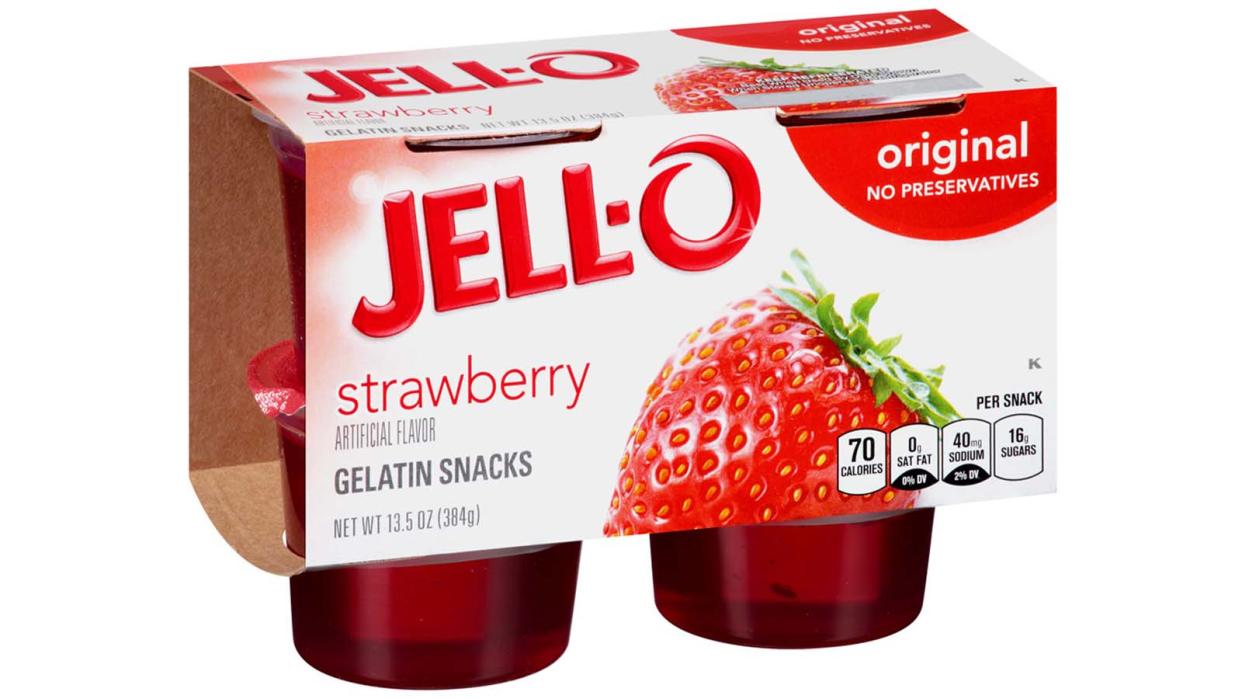What Exactly Is Jell-O Made From?

"Watch it wiggle, see it jiggle." Those of us old enough surely remember this TV jingle for Jell-O. And if you don't, chances are good that you've eaten the stuff at some point in your life. There are endless recipes that use Jell-O to create everything from simple squares to ornate molds that incorporate varied flavors, fruits and whipped toppings.
But here's the million-dollar question. What is Jell-O?
Jell-O is a brand-name of gelatin made by Kraft Heinz. It includes a few basic ingredients:
water
sugar or artificial sweetener
fruit juices for flavoring (like strawberry concentrate)
gelatin
coloring
But what is it about Jell-O that lets you mold it into so many different shapes? In a word gelatin.
But what is gelatin? Gelatin is a processed version of a structural protein called collagen. It comes from animals, including humans, and makes up almost one-third of all the protein in the human body.
Collagen is a fibrous protein that strengthens the body's connective tissues and allows them to be elastic — that is, to stretch without breaking. As you get older, your body makes less collagen, and individual collagen fibers become increasingly cross-linked with each other. You might experience this as stiff joints from less flexible tendons, or wrinkles due to loss of skin elasticity.
Gelatin can come from the collagen in cow or pig bones, hides and connective tissues. The gelatin in Jell-O is most likely from pigskin.
Collagen doesn't dissolve in water in its natural form, so it must be modified to make gelatin. Manufacturers grind the pigskin and treat it with a strong acid for about 24 hours. Then the pretreated skin is boiled to unravel the protein bonds in the collagen. The resulting product is a gelatin solution.
There are, of course, safety controls at every step of the process ensure purity. That final solution is chilled into a jelly-like material, cut and dried. At this point, the dried gelatin — about 10 percent water — is ground. If it's going to make Jell-O, it will be ground into a fine powder.
How does this powder become the Jell-O we eat?

What Makes Jell-O Wiggle and Jiggle?
When you buy a box of Jell-O, you get a small packet of the powdered gelatin that also contains sugar or artificial sweetener, flavorings and colors added. At room temperature, the gelatin protein is in the form of a triple helix. This is a fairly ordered structure not unlike that of DNA. With DNA, two chains of nucleotides are twisted together in a spiral pattern resembling a ladder, in a design known as a double helix.
The gelatin protein has three separate chains of amino acids (called polypeptide chains) lined up and twisted around each other. These amino acids are mostly glycine, proline and hydroxyproline. Weak bonds hold the helix together.
To make a gelatin mold, you add boiling water to the powdered gelatin. You then stir the mixture for about three minutes until the gelatin dissolves completely and allow it to set in a refrigerator.
What happens to gelatin when you add boiling water? The energy of the heated water breaks the weak bonds that hold the gelatin strands together. The helical structure unwinds, and you're left with free-floating protein chains. When you refrigerate the Jell-O mixture, the chains slowly come back together again.
But instead of reforming into a perfect triple helix, some of the liquid gets trapped between the polypeptide chains. So the Jell-O becomes a trapped liquid in protein chains, or something that acts like a solid, but not really one. This is the Jell-O "jiggle" that everyone loves. Scientists call this stage a colloid, or the substance formed when tiny particles are dispersed within a solution.

What Other Foods Have Gelatin?
Gelatin is a common ingredient in foods because it's so versatile. It can be used as a gelling agent (as in Jell-O), or as a thickener, to give foods a more pleasing texture. It's also used to emulsify (or stabilize) processed foods, and to clarify juices, vinegars and even beer. It's in everything from yogurt to chewing gum.
There also are types of gelatins made from certain animals like fish to meet dietary and religious standards. And those who eat vegan or vegetarian diets should look for special gelatin versions suited for them.
Here are some other foods that commonly contain gelatin:
gummy bears
sour cream
margarine
jelly
cream cheese
cake icing and frosting
soups, sauces and gravies
canned ham and chicken
corned beef
sausage
whipped cream
Gelatin is even used to make the coating for pills that makes them easier to swallow. It's also in lozenges and ointments. Cosmetics may contain a form of gelatin that doesn't gel. You may see it on the label as "hydrolyzed collagen."
Lots More Information
Related Articles
More Great Links
Sources
Chemistry Daily: The Chemistry Encyclopedia. "Gelatin." (Sept. 24, 2011) http://www.chemistrydaily.com/chemistry/Gelatin
David Joachim and Andrew Schloss Fine Cooking. "The Science of Gelatin."
Gelatin Manufacturers Institute of America. "How We Make Gelatin." (May 20, 2022) http://www.gelatin-gmia.com/uploads/1/1/8/4/118450438/gmia_gelatin_manual_2019.pdf
Goodsell, David. "Collagen: April 2000 Molecule of the Month." Protein Data Bank. (Sept. 26, 2011) http://www.pdb.org/pdb/101/motm.do?momID=4
Harvard T.H. Chan School of Public Health. "Collagen." (May 20, 2022) https://www.hsph.harvard.edu/nutritionsource/collagen/
Joachim, David; Schloss, Andrew. Fine Cooking. "The Science of Gelatin." (May 20, 2022) https://www.finecooking.com/article/the-science-of-gelatin
Kraft Heinz Food Service. "JELL-O Strawberry Gelatin." (May 20, 2022) https://www.kraftheinz-foodservice.com/product/10043000052690/JELLO-Strawberry-Gelatin-33-oz-Cups-46-Count
New Mexico Institute of Mining and Technology. "The Science of Jell-O." (Sept. 24, 2011) http://infohost.nmt.edu/~fuierer/Mate%20101L%20Posters/Jello%2520revised.pdf
PETA. "Everything You Never Really Wanted To Know About Gelatin." Oct. 29, 2021. (May 20, 2022) https://www.peta.org/living/food/everything-never-really-wanted-know-gelatin/
Senese, Fred. "What's Jell-O Made of?" General Chemistry Online. Frostburg State University. (Sept. 26, 2011) http://antoine.frostburg.edu/chem/senese/101/consumer/faq/jello-composition.shtml
Original article: What Exactly Is Jell-O Made From?
Copyright © 2024 HowStuffWorks, a division of InfoSpace Holdings, LLC, a System1 Company


